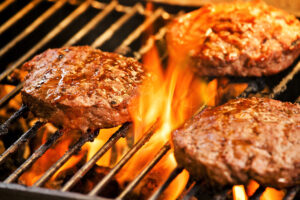Whoppers, Wimpy, and Wahlburgers. Jimmy Buffet sang Cheeseburger in Paradise and Ronald McDonald clowned for the world.
Where’s your beef?
Hamburgers are an American icon as well as one of the most popular sandwiches in the world. Fifty billion burgers are eaten each year in America; roughly 1.5 million Big Macs are sold every day. Globally, 2.6 billion burgers are chowed down yearly.
That’s a lot of beef patties, special sauce, lettuce, cheese, pickles, and onions on a sesame seed bun.
Where did it begin? No one knows. The ancient Romans had a recipe similar to today’s hamburger. A Nat Geo documentary says it came from twelfth century Genghis Khan and his Mongols. They tucked meat beneath their saddles to tenderize it. The Russians turned the Mongolian meat into steak tartar and the Germans dubbed it the “Hamburg Steak.”
A mid-seventeenth century cookbook by Hannah Glasse included a recipe for “hamburgh sausage.” By the late nineteenth century “Hamburger Steaks” were talked about in dozens of newspapers. According to Erik Ofgang in The Washington Post, in 1887 a New York lodging house advertised “a bowl of coffee, hamburger steak, and bread” for 10 cents.
A lot cheaper than today’s Quarter-pounder.
Hamburgers are an evolution not revolution.
Don’t tell that to the people who battle for the right of the American hamburger’s origin. There was Louis Lassen in New Haven, Ct. who, in 1900, prepared “take out” with a “Hamburger Steak” nestled between two slices of toast. Fletcher Davis from Athens, Texas introduced the burger at the 1904 St. Louis World’s Fair. Tom Fraker from Reno, Nevada ran a saloon lunch counter featuring “hamburgers.”
It spread faster than ice cream in a heat wave.
In 1995, Governor Frank Keating of Oklahoma, declared that the birthplace of the hamburger was Tulsa. In 2007 the state legislature voted that Seymour, Wisconsin was the home of the hamburger. Genghis Khan shuddered.
Now we have a vast variety of burgers, burger houses, and fast food joints. From Whataburger to the Baconator, we’re drowning in choices. Omaha Steaks, Delmonico’s, and turkey, bison, and chicken burgers joined the competition. There’s plant-based burgers from Impossible and Beyond Meat.
The most expensive is the $330,000 Stem Cell Burger (made from 20,000 strands of cow muscle in The Netherlands). Maybe the largest is the $1200 Absolutely Ridiculous Burger that weighs over 338 pounds – perfect for a pack of hungry teenagers.
Check out upscale burgers like the Golden Boy from the Netherlands ($5964), the Fleur Burger from Las Vegas ($5000), and the Glamburger ($1,770) spiced with flecks of edible gold that don’t stick in your teeth.
Most of us get our burgers from the backyard grill, McDonald’s, and popular burger joints. Some people call it the burger wars – which fits in fine with Genghis.
It began with White Castle, who, according to Kate Kelly in America Comes Alive, “holds the title of being the first fast-food restaurant in the world.” Opened in 1921, it was the first to sell over a billion burgers.
Sorry Ronald.
McDonald’s opened in 1940 as a burger and milk shake joint owned by two bothers in San Bernardino, California. They used an assembly line system that made it possible to sell a 15 cent burger. In 1961 Ray Kroc bought them out for $2.7 million. He introduced the Golden Arches and built the McDonald’s we know today.
Burger King followed, originally called Insta-Burger – inspired by McDonald’s in 1953. BK had a rough history of owners, changes, and restructuring. Although claiming over 18,000 locations around the world, BK doesn’t come close to McDonald’s over 40,000 stores.
Lastly, there are the “smaller” contenders like Wendy’s, In-N-Out, Sonic . . . and lots of local favorites.
There’s no question that these days when it comes to hamburgers you can have it your way.







White Castle…now that brings back some memories. I enjoyed this article as much as I’ve enjoyed so many excellent burgers!